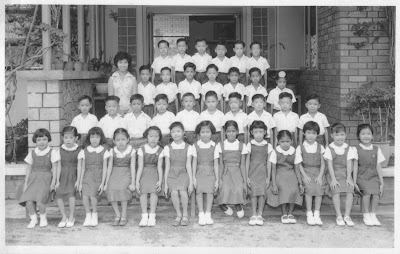 I've been going in and out of a flat along Tiong Bahru Road the past 1 week.
I've been going in and out of a flat along Tiong Bahru Road the past 1 week.
And you couldn’t have missed the numerous ripe mangos that are just hanging outside the windows.
And I have even joked about how plucking these mangos from the flat could be an extracurricular activity if the tenants do rent the flat.
As usual, it was just that kind of pointless banter and I do not really meant what I said.
But after reading an article in the Straits Times (See Below) about the huge mango harvest in Tampines, I finally took action today.
No! I did not rush down to pluck those mangos!
I merely took my camera to snap some pictures to proof that we also have a mini mango harvest here at the Tiong Bahru Estate.  I think this could be the only mango tree around here and I wonder when the fruits will be harvested by the town council.
I think this could be the only mango tree around here and I wonder when the fruits will be harvested by the town council.
(Maybe the tree is not even theirs as some pioneer residents could have planted this tree a few decades ago)
The low hanging fruits are long gone.
There are still plenty to pluck if you have long legs or some device to get them.
However, please note that it is illegal to pluck these fruits and you could be fined!
I know we could buy these off the market but somehow forbidden fruits always seemed to taste a lot better. (Evil Laughter)
And I won’t tell you where this tree could be found. (Evil Laughter again)
You’ve got to guess where the tree is standing from the pictures and I’m sure the resourceful ones will be able to locate it.________________________________
 Volunteers at the Tampines Street 12 community garden displaying their bountiful harvest. About 300 to 400 mangoes were distributed among residents, who also enjoyed themselves at a carnival yesterday. -- PHOTO: CHEW SENG KIM
Volunteers at the Tampines Street 12 community garden displaying their bountiful harvest. About 300 to 400 mangoes were distributed among residents, who also enjoyed themselves at a carnival yesterday. -- PHOTO: CHEW SENG KIM The Straits Times
April 19, 2009
By Shuli Sudderuddin
Mango season hits the streets
Fruit from roadside trees will be harvested for charity; bumper crop due to extended dry weather
While some people are wilting during the current hot, dry spell, it has been 'raining' mangos - from the roadside trees.
So much so that the National Parks Board (NParks) will have a harvest, for the first time, for charity.
Other flowering trees and shrubs have also been lush, but mango trees across the island are 'fruiting particularly heavily this year', said an NParks spokesman.
The mango harvest along Tampines avenues 2 and 4 is said to total 300 to 400 fruits.
This Friday, they will be given to NParks' adopted charity, the Handicaps Welfare Association.
In the 1980s, the Government started planting fruit trees to add variety to the landscape.
There are now close to 25,000 fruit trees such as coconut, mango, jackfruit and rambutan.
NParks said the bumper crop might have been triggered by the extended dry weather earlier this year.
Professor Richard Thomas Corlett of the National University of Singapore's biological sciences department explained: 'Many trees, both wild and cultivated, are flowering and fruiting more this year.
'In most cases, this is a response to the long dry period in January, when rainfall was 80 to 90 per cent below normal.
This has triggered flowering between late March and now in many roadside trees and shrubs.'
He added that plants of the same species need to flower at the same time so that flowers can pollinate one another.
Assistant Professor Shawn Lum of the natural science and science education department of the National Institute of Education said mango trees tend to flower every year at this time, but that drought increases the intensity of the flowering.
There is no consensus on why this is so.
Apart from the roadside trees, those in community gardens are also enjoying an abundant harvest.
In 2005, NParks introduced its 'Community In Bloom' project to encourage and facilitate gardening efforts in housing estates.
Over 300 gardening groups have blossomed since, and the fruits of their labour are plentiful this year.
Said the NParks spokesman: 'Most of the fruit harvest will go to the gardeners, while some will be given to charitable groups, residents' committees and residents' associations.'
Yesterday, residents at Tampines Street 12 celebrated the mango harvest from their community garden with a carnival, at which about 300 to 400 mangos were distributed.
Outside of community gardens, however, the plucking of fruit from roadside trees without permission is an offence which carries a fine of up to $5,000.
But this has not deterred some people from sampling the forbidden fruit.
IT consultant Darwin Lim, 32, lives along Upper East Coast Road, where at least 20 mango trees are flourishing.
He said: 'Sometimes I see people picking them. I think that it's a good thing or all the mangos will go to waste when they fall.'
One resident along Tampines Street 12 was seen plucking mangos from trees with a homemade device - a broom handle with a net on the end.
The 60-year-old retiree, who wanted to be known only as Mr Tan, said: 'I've lived here for 20 years and every year the harvest is wasted. There are so many mangos this year.
What harm does it do if I take just three or four?'
























